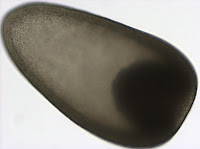 I found this gastrula in a plankton sample taken from the Charleston marina docks on May 17th. We speculated that it may be a sea cucumber (class Holothuroidea; phylum Echinodermata) because of its unusual shape. One can see in this picture that the gastrula is longer than wide and tapers toward the animal pole (upper left). In holothuroids, gastrulation begins by invagination whereby cells at the vegetal pole (bottom right) fold into the blastocoel (the cavity within the embryo) as a layer, rather than ingress individually (McEuen 1987). One can see these invaginating cells in this gastrula as an opaque area. This embryo later confirmed our suspicions and developed into a lecithotrophic (non-feeding) doliolaria (planktonic larva of some holothuroids).
I found this gastrula in a plankton sample taken from the Charleston marina docks on May 17th. We speculated that it may be a sea cucumber (class Holothuroidea; phylum Echinodermata) because of its unusual shape. One can see in this picture that the gastrula is longer than wide and tapers toward the animal pole (upper left). In holothuroids, gastrulation begins by invagination whereby cells at the vegetal pole (bottom right) fold into the blastocoel (the cavity within the embryo) as a layer, rather than ingress individually (McEuen 1987). One can see these invaginating cells in this gastrula as an opaque area. This embryo later confirmed our suspicions and developed into a lecithotrophic (non-feeding) doliolaria (planktonic larva of some holothuroids).  Doliolariae are shaped like a barrel (hence the name) and are ciliated. Cilia may cover the entire surface (uniform ciliation) or form 2-5 discrete transverse bands. Ciliated bands often develop from an initially uniformly ciliated area of epidermis (Miller 2001). On May 23rd (left) two ciliary bands were present in this larva in addition to a uniformly ciliated anterior area (left on this image).
Doliolariae are shaped like a barrel (hence the name) and are ciliated. Cilia may cover the entire surface (uniform ciliation) or form 2-5 discrete transverse bands. Ciliated bands often develop from an initially uniformly ciliated area of epidermis (Miller 2001). On May 23rd (left) two ciliary bands were present in this larva in addition to a uniformly ciliated anterior area (left on this image).  By May 25th, the uniformly ciliated region had developed into yet another discrete band of cilia (three in total), seen in the third photograph.The duration of the doliolaria larval stage is species specific, ranging from six to thirteen days in the local species with described development (Miller 2001). The end of planktonic period is marked by the protrusion of five primary tentacles from the larval vestibule. One can see several curved projections in the larval epidermis (upper left in the third image) through which these tentacles will eventually emerge. At that point the larva will be called a pentactula.
By May 25th, the uniformly ciliated region had developed into yet another discrete band of cilia (three in total), seen in the third photograph.The duration of the doliolaria larval stage is species specific, ranging from six to thirteen days in the local species with described development (Miller 2001). The end of planktonic period is marked by the protrusion of five primary tentacles from the larval vestibule. One can see several curved projections in the larval epidermis (upper left in the third image) through which these tentacles will eventually emerge. At that point the larva will be called a pentactula. Although sea cucumbers are relatively soft bodied, internal calcareous ossicles are used for structure and support. In this polarized light image, one can see a small ossicle as well as a larger ring of ossicles that will surround the pharynx in the adult sea cucumber (Ruppert et al. 2004).
Although sea cucumbers are relatively soft bodied, internal calcareous ossicles are used for structure and support. In this polarized light image, one can see a small ossicle as well as a larger ring of ossicles that will surround the pharynx in the adult sea cucumber (Ruppert et al. 2004).
Miller, B. 2001. Echinodermata. In: An Identification Guide to the Larval Marine Invertebrates of the Pacific Northwest. Edited by Alan Shanks. OSU Press, Corvallis.
McEuen, SF. 1987. Echinodermata: Holothuroidea. In: Reproductive and Development of Marine Invertebrates of the Northern Pacific Coast by Megumi Strathmann. University of Washington Press, Seattle.
Ruppert, E. E., R. S. Fox and R. D. Barnes. 2004. Invertebrate Zoology: A Functional Evolutionary Approach. Brooks Cole, Belmont, CA.
No comments:
Post a Comment